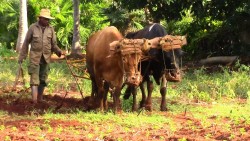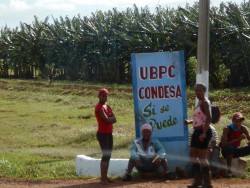By Leonor Hurtado
The land represents economic, political and social power
The land is a means of production that allows us to produce food and various assets. Historically in the world, land and territory have been at the root of disputes because they represent economic, political and social power.
Before the Revolution, the land belonged to the plantation owners, US and other companies that produced monocultures, principally sugar, tobacco and coffee. After toppling the US-supported Batista dictatorship, the Revolution carried out three Agrarian Reforms in Cuba:
- The first Agrarian Reform in 1959 expropriated the large land-holdings. The State took part of the land and part was handed over to the peasants. The maximum size of a farm was 988 acres (400 hectares). The State continued producing monocultures with industrial agriculture supported by the Soviet Union (USSR). The peasants produced individually or in cooperatives.
- The second Agrarian Reform was in 1963, to eliminate the social class of land-owners that were exploiting the workers. The maximum size of the farm was reduced to 165 acres (67 hectares), and between 1963 and 1968 the ownership of State land increased from 60 to 82%. The State farms continued producing monocultures with salaried workers.
- In 1988 the government amended the Agrarian Reform with Decree 125, which regulated the possession, ownership and inheritance of the land agricultural resources. Then the State distributed 251,029 acres (101,588 hectares) of land.
- The third Agrarian Reform was in 1993; it redistributed land in usufruct to the workers; 60% of State land has been distributed.
- In 2008, another amendment provided for the acquisition of land in usufruct to whomever requests land for planting food.
In Cuba the land is available for every Cuban who wants to work it. Farmers are usually organized in cooperatives for agricultural and livestock production: Cooperatives of Agricultural Production (Cooperativa de Producción Agropecuaria or CPA), Cooperatives of Credit and Service (CCS) and Basic Units of Cooperative Production (UBPC). The UBPC’s were created with the third Agrarian Reform in 1993; it is an autonomous socio-economic community of agricultural and livestock production. Generally they continue with the same products produced when they were State farms, but now the land belongs to the farmers in usufruct. The farmers sign a production contract with the State, committing to produce a certain quantity of products which they market directly through the State at the established price. Farmers can sell excess harvests in farmers markets or to individual consumers at the going market price.
In Cuba the land is available for every Cuban who wants to work it.
In spite of the Agrarian Reforms and the promotion of agricultural and livestock production, in 2007 51% of Cuba’s arable land was unoccupied. To confront the problem of idle land, in 2008 Decree 259 gave land in usufruct for 10 years, renewable for 25 more years, to whomever had the ability and resources to make it produce. Someone without land can receive 33 acres (13.42 hectares) to begin with; someone with land that is fully producing can receive 99 more acres (30.26 hectares). The land is available to whomever commits to working it.
Throughout the world corporations and powerful national elites are evicting peasants from their lands. The land is the most precious asset and is seized violently by those who wield economic and political power, supported by the governments and the military. Small farms are disappearing as land concentrates in fewer and fewer greedy hands that produce money, not food; raping the land, contaminating it with chemicals with no concern about the quality of their production. It’s not like that in Cuba – the land is available to whomever wants to work it, but I noticed that the majority of young men and women do not want to work the land.



 Help Food First to continue growing an informed, transformative, and flourishing food movement.
Help Food First to continue growing an informed, transformative, and flourishing food movement.




